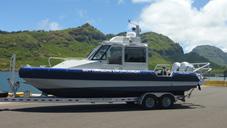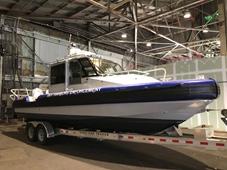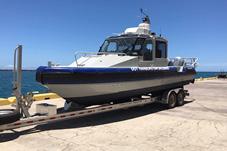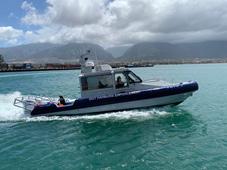
5 minute read
Harbors
Are You Ready?
By: Joy Zhang
While the origin and cure to this ongoing COVID-19 pandemic remain an enigma, City and County of Honolulu (CCH) Department of Facility Maintenance (DFM) has started its expedition to form a Storm Water Utility as a more reliable funding mechanism for Oahu Island’s storm water management, the upkeep annual cost of which is about 91.6 million dollars with 24% from State Highway and 76% from CCH’s Property Taxes.
What is a Storm Water Utility exactly?
In DFM’s proposal, it is a Storm Water Fee to be charged to all Property Owners, taxable and nontaxable, (including, but not limited to all land owners, federal/state governments, and churches). Impervious area would be the basis for fees. In other words, the more impervious area you own, the more you pay. Meanwhile, all property owners in a Storm Water Utility are eligible for credits or rebates through implementation of certain storm water management measures (such as, re-direct downspouts to a rain garden, capture and use roof runoff, etc.), which could be deducted from the storm water fee you have to pay. In summary, Storm Water Utility can provide municipalities with dedicated, fee-based funding available exclusively for storm water management purposes. Since the 1990s, over 2,000 United States and Canadian cities have adopted a storm water utility. A draft Storm Water Rates is tabulated below.
What challenges lead to all of this?
Following its natural way, millions of gallons of rain water falls on our island almost every day. When rain water is absorbed into the soil, it is filtered and ultimately replenishes local aquifers, or it flows into streams and the ocean. However, when heavy rain hits the ground, soil saturated by water creates excess moisture that runs across the surface and into storm conveyance system and road ditches. This rain water often carries debris, litter, chemicals, bacteria, eroded soil, and other pollutants and flows into nearby streams, wetlands, and the ocean. Modern urbanization and an increasing of impervious surfaces prevent precipitation from naturally percolating back into the soil, robbing our island’s groundwater supply of replenishment. In addition, this excess runoff can create localized drainage flooding issues.
See STORMWATER on page 10
Harbors
STORMWATER continued from page 9
In recognizing these challenges that “If Hawaii does not begin planning ahead, ensuring the islands’ supply of fresh water in the future may cost the public a great deal…”, Hawaii’s State Legislature adopted a bill that allows counties to set up storm water utilities.
Based on the core values of Clean Water, Healthy & Safe Environment, Community Involvement, and Shared Responsibility, the Storm Water Utility come into play.
What’s coming down the road with this Storm Water Utility?
Resonating to these challenges and a possible solution, CCH would like to engage the community and continue collecting input as part of studying options for a future storm water utility for Oahu. A Stakeholder Advisory Group has been convened. As part of a robust public involvement program, the first round of community meetings began on February 3, and a series of virtual community meetings were held during this May. In consideration of the negative impacts resulted from the CVOID-19 pandemic crisis, the DFM is proposing a revised study to delay introduction of fees and to include a strong equity plan for our kūpuna, low-income families, and nonprofits. Later this summer, the CCH DFM will present a bill to the City Council to establish the utility. The bill will include provisions to delay any payment of storm water utility fees until July 1, 2022 or later and be contingent upon economic recovery indicator. The bill will also include deadlines for DFM to complete an island-wide Storm Water Master Plan, a detailed credit program, and a plan for geographic re-investment in O‘ahu’s communities.
For more information about CCH’s Storm Water Utility Study, please watch the introductory video here.
Have a question, comment, or other feedback about the proposed Oahu Storm Water Utility?
Write to: Department of Facility Maintenance City and County of Honolulu 1000 Uluohia Street, Suite 215 Kapolei, HI 96707-2040
Email to: stormwater@honolulu.gov; or
Fill out the form online at: https://www.stormwaterutilityoahu.org/contact-2/

Harbors
Boats Commissioned for Security & Recovery Efforts
By: Davis Yogi


The State of Hawaii, Department of Transportation, Harbors Division announced commissioning three (3) 27foot long and one (1) 29-foot long aluminum monohulled boats new Security and Disaster Recovery vessels to be launched at Hilo and Kawaihae Harbors, Hawaii; Kahului Harbor, Maui with capability for crossing the channels to support recovery efforts at Kaumalapau Harbor, Lanai, and Kaunakakai Harbor, Molokai; and Nawiliwili Harbor, Kauai.
The Harbors Division paid $1.27 million after assessing liquidated damages, storage fees, and other costs for the vessels,. The vessels were designed in collaboration with the US Army Corp of Engineers and equipped with carry side scan sonar designed to conduct first response assessments of underwater hazards that can obstruct safe navigation or prevent vessels from tying up to our piers after a tropical storm, earthquake, hurricane or tsunami. The e new Security and Disaster Recovery vessels and underwater detection capability is an important addition to the Harbor Division’s capabilities to respond to disasters to survey underwater obstructions and resumption of operations to our neighbor islands.


The new 27 foot Security and Disaster Recovery vessels home ported in Hilo and Kawaihae Harbors have been named the Kuleana meaning responsibility, duty, obligation will be home ported in Hilo, the
Kokua meaning to help, give aid will be stationed in Kawaihae. The Kalewa meaning to move from place to place; to move or float with the wind will be kept at Nawiliwili Harbor will be used to respond when needed to both Nawiliwili and Port Allen Harbors. The fourth, the 29-foot Ke Ali`i o Ke Kai meaning The Chief of the Sea to be primarily located in Kahului but will see service between Kahului
Harbor Maui, Kaunakakai
Harbor Molokai and
Kaumalapau Harbor, located on the island of
Lanai.









